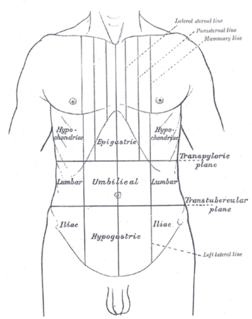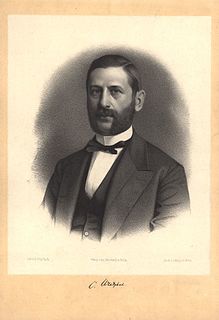Related Research Articles
Paroxysmal attacks or paroxysms are a sudden recurrence or intensification of symptoms, such as a spasm or seizure. These short, frequent symptoms can be observed in various clinical conditions. They are usually associated with multiple sclerosis or pertussis, but they may also be observed in other disorders such as encephalitis, head trauma, stroke, asthma, trigeminal neuralgia, breath-holding spells, epilepsy, malaria, tabes dorsalis, and Behçet's disease, paroxysmal nocturnal hemoglobinuria (PNH). It has also been noted as a symptom of gratification disorder in children.

Jean Alexandre Barré was a French neurologist who in 1916 worked on the identification of Guillain-Barré-Strohl syndrome, as well as Barré–Liéou syndrome.

Tabes dorsalis is a late consequence of neurosyphilis, characterized by the slow degeneration of the neural tracts primarily in the dorsal root ganglia of the spinal cord. These patients have lancinating nerve root pain which is aggravated by coughing, and features of sensory ataxia with ocular involvement.

Abdominal pain, also known as a stomach ache, is a symptom associated with both non-serious and serious medical issues.

Abadie's sign of exophthalmic goiter is a medical sign characterized by spasm of the levator palpebrae superioris muscle with retraction of the upper lid seen in Graves-Basedow disease which, together with exophthalmos causes the bulging eyes appearance.

Moritz Heinrich Romberg was a Jewish physician from Berlin who published his classic textbook in sections between 1840 and 1846; Edward Henry Sieveking translated it into English in 1853. His nephew was Eduard Heinrich Henoch, who was known for describing Henoch–Schönlein purpura.

Vital signs are a group of the four to six most important medical signs that indicate the status of the body’s vital (life-sustaining) functions. These measurements are taken to help assess the general physical health of a person, give clues to possible diseases, and show progress toward recovery. The normal ranges for a person’s vital signs vary with age, weight, gender, and overall health.

Neurosyphilis refers to infection of the central nervous system in a patient with syphilis. In the era of modern antibiotics the majority of neurosyphilis cases have been reported in HIV-infected patients. Meningitis is the most common neurological presentation in early syphilis. Tertiary syphilis symptoms are exclusively neurosyphilis, though neurosyphilis may occur at any stage of infection.

The nucleus proprius is a layer of the spinal cord adjacent to the substantia gelatinosa. The nucleus proprius can be found in the gray matter in all levels of the spinal cord. It constitutes the first synapse of the spinothalamic tract carrying pain and temperature sensations from peripheral nerves. Cells in this nucleus project to deeper laminae of the spinal cord, to the posterior column nuclei, and to other supraspinal relay centers including the midbrain, thalamus, and hypothalamus. Rexed laminae III and IV make up the nucleus proprius.
Wilhelm Heinrich Erb was a German neurologist. He was born in Winnweiler, and died in Heidelberg.

Karl Friedrich Otto Westphal was a German psychiatrist from Berlin. He was the son of Otto Carl Friedrich Westphal (1800–1879) and Karoline Friederike Heine and the father of Alexander Karl Otto Westphal (1863-1941). He was married to Klara, daughter of the banker Alexander Mendelssohn.
Jean Nageotte was a French neuroanatomist born in Dijon.

Jean Marie Charles Abadie was a French ophthalmologist who was a native of Saint-Gaudens.
Abadie may refer to:
Stomping gait is a form of gait abnormality.
Joseph Louis Irenée Jean Abadie was a French neurologist who is remembered for naming Abadie's symptom.
Carl Julius Peter Behr was a German ophthalmologist born in Hamburg. In 1909 he described an hereditary syndrome of optic and neurologic disorders now known as Behr's syndrome.

Jean Marie Marcel Albert Pitres was a French neurological physician. He was born in Bordeaux and received his training in Paris, where he was the student of Jean Martin Charcot (1825–1893) and Louis-Antoine Ranvier (1835–1922). He served as dean of the Faculty of Medicine at the University of Bordeaux – appointed 1885.

Malum perforans is a long-lasting, usually painless ulcer that penetrates deep into or through the skin, usually on the sole of the foot. It is often a complication in diabetes mellitus and other conditions affecting the nerves.
Hutchinson's mask is a patient's sensation that the face is covered with a mask or a gauzy network like cobwebs. This medical sign is associated with tabes dorsalis affecting the trigeminal nerve. It is named in honour of the English physician Sir Jonathan Hutchinson (1828–1913).
Subjective sensations of various kinds, as numbness, pins and needles, formication, a cold trickling feeling in the skin, a feeling in the soles of the feet of walking on putty, wool, or velvet may be complained of. In rare cases Hutchinson's mask, due to affection of the fifth, occurs. The patient says his face feels stiff, and he feels as if it were covered by a cobweb.
References
- ↑ Campbell, William W. (25 August 2015). Clinical signs in neurology: a compendium. ISBN 978-1-4963-2814-4. OCLC 944130839.
- ↑ synd/54 at Who Named It?
- ↑ Gazette hebdomadaire des sciences médicales de Bordeaux, 1905, volume 26, p 408.
| This medical symptom article is a stub. You can help Wikipedia by expanding it. |